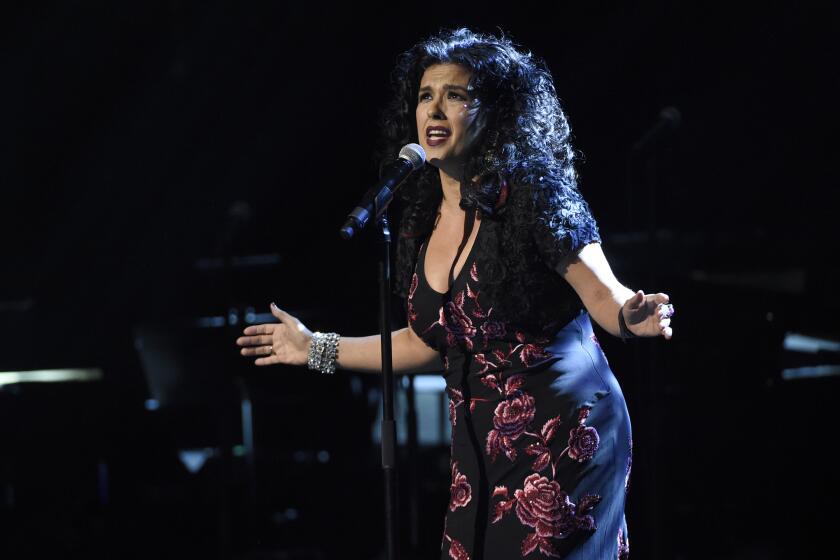POP MUSIC REVIEW : It’s New Orleans Jazz but Pizazz Proves to Be Elusive : Preservation Hall Band’s Performance Less Than Memorable
- Share via
The traditional sound that the Preservation Hall Jazz Band aims to preserve is important not just because it dates back to around the turn of the century, but because it is such a clear example of music that springs from a community and exists to meet that community’s needs.
When people in Jazz Age New Orleans wanted to parade through the streets in celebration, the music propelled them on their way. When it came time to mourn, jazz was inseparable from the ritual. Sometimes the music’s purpose was to guide the soul in spiritual yearning. Sometimes it appealed to more earthy appetites.
On Saturday night, that sense of purpose was too often lacking. The seven-member band led by trumpeter George (Kid Sheik) Colar offered plenty of tasty playing, but too often it failed to make traditional jazz’s past or present seem vibrant.
The Kid Sheik band is one of several distinct touring units made up of players based at Preservation Hall, the New Orleans institution dedicated to keeping traditional jazz alive. It certainly has musicians who qualify as experts in their field.
Colar, 79, bassist Frank Fields, pianist Jeanette Kimball and trombonist Louis Nelson are all in their 70s or 80s, and all came up playing New Orleans jazz (Fields also is known for his work as a sideman on records from New Orleans’ rhythm and blues boom of the 1950s).
The three younger Preservation Hall recruits who joined the veterans proved themselves to be apt students. Playing to a large, receptive audience at the South Coast Community Church in Irvine, they offered a consistently pleasant time but few moments that were truly vivid.
The band’s handling of one of the staple New Orleans jazz songs, “Just a Closer Walk With Thee,” illustrated the problem. The tune is a funeral march, but anyone who had to rely on Saturday night’s version for his earthy send-off would have to consider himself poorly mourned.
Only Nelson’s subdued trombone solo, played in a choked whisper, did justice to the occasion. Orange Kellin, the clarinetist from Sweden, offered soloing that was dexterous and mellifluous, but far too sprightly. According to tradition, after the funeral march has heaved to a sad halt, the funerary musicians do an about-face and rollick the tune home, ending the burial with the joyful thought that the departed soul is now delighting in heaven. This time, the band dispensed with the happy turnabout. Not much of an example of a jazz funeral there.
Nothing else in the 105-minute concert explored the spiritual roots of jazz. Missing was the gorgeous song of faith “His Eye Is on the Sparrow.” Offered in its place was schmaltz--a bland but well-received rendition of “What a Wonderful World,” the Louis Armstrong tune recently included for ironic effect in the movie “Good Morning Vietnam.” Colar sang it and a few other vocal numbers in a wizened, tenuous voice. Many of the best moments in the show came from the band’s oldest member. Nelson, trim and erect at 85, with a full head of white hair and bushy, white eyebrows, played several trombone solos that substituted clipped phrasing and restrained dynamics for the instrument’s more typical sassy braying. On “Whispering,” his set-piece for the evening, Nelson achieved a wistful, airy sound that could have been emanating from the worn grooves of an old-time 78-r.p.m. record.
Kimball’s piano solos also were strong, cool and smooth, yet keeping a sense of playfulness. The other soloists were capable--the two relative youngsters, Kellin and banjoist Neil Unterseher, got some of the biggest cheers--but they didn’t reach for any surprises.
As an ensemble, the Kid Sheik band was at its best on “Basin Street,” achieving a nice, wobbly swing that sounded like pleasant inebriation, and on the mandatory show-closer, “When the Saints Go Marchin’ In.” The finale featured the customary parade around the hall, with 20 or 30 concert-goers falling in behind three ambling musicians and high-stepping it to the stage.
Other than the closing parade and the band’s occasional cues to clap hands, there wasn’t much interaction between musicians and audience. There were no song introductions, no playful dance steps, and little else that might forge a personal link between players and listeners. Interaction within the band consisted mainly of brief repartee during Fields’ bass solos, a running joke that quickly grew tiresome.
Preservation Hall has kept alive a musical community. This group of the hall’s representatives could have done more to convey what that’s all about.
More to Read
The biggest entertainment stories
Get our big stories about Hollywood, film, television, music, arts, culture and more right in your inbox as soon as they publish.
You may occasionally receive promotional content from the Los Angeles Times.









